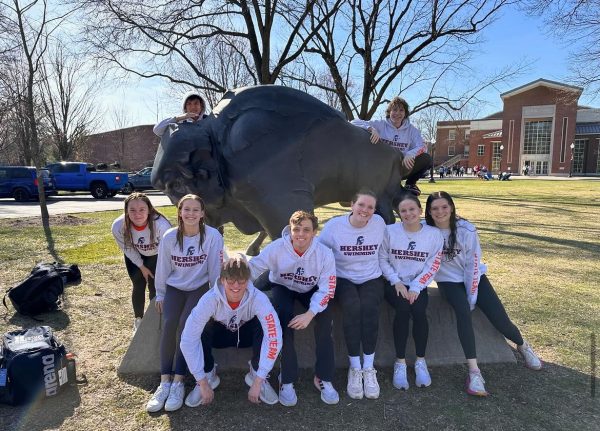Vandalism, fights, “big emotions,” and discipline
HHS staff help struggling students remember how to behave at school as COVID wanes
April 21, 2022
Since returning to in-person instruction following COVID-19, schools all over the country are dealing with the behavioral and emotional impacts that quarantine has had on students. Hershey High School is no exception.
Students went two years without having daily instruction face to face, social support, or the continuation of behavioral development. When returning, they failed to show the proper behavior the district was expecting. Students struggled with the rapid change as a result of minimal integration.
Principal Lindsey Schmidt said, “Kids were coming back and they didn’t know how to deal with their emotions. They were having big feelings, and so there were some more physical outbursts than we were probably used to because everyone was experiencing something new.”
According to Schmidt, these behaviors were shown in visible ways such as vandalism, outbursts, and fights, but also in less obvious ways like putting heads down and refusing to participate in class. When kids feel connected, they make better choices. But with years of being isolated at home, students are losing that crucial social connection with peers. While the administration was expecting some rocky aspects of the adjustment, they underestimated the exact challenges that were ahead.
Since the beginning of the school year, there have been reports of vandalism, physical outbursts, and explicit and offensive language.
“We saw an uptick [in vandalism] at the beginning of the school year because of TikTok with the devious licks,” said Schmidt, “so that was something we were never seeing prior…”
At the beginning of the school year, there were a series of physical altercations taking place. Students were being targeted by larger groups and fights would take place.
Freshman Molly Sargent had concerns. “People are a lot more crazy than they were last year,” Sargent said. “They do not know how to act.”
Sargent was not alone in her views and some went further saying they worried for their own safety.
Freshman Naomi Tanjung said, “It’s kinda unsafe in the bathrooms sometimes just because of what happened before.”
In an attempt to solve some of these issues, the school implemented a new bathroom policy. Students were not allowed to use the bathrooms in the first or last 10 minutes of class, and they were required to go one at a time. The goal was to reduce bathroom traffic, which would in return, hopefully, reduce the number of altercations.
Some students felt this was unfair and instead were punishing students who were not involved.
“I feel like they just try to find the quickest possible solution without looking at the consequences of it,” said Melissa Voyles, a senior at Hershey High School.
Schmidt said that no policy is implemented without serious consideration involving what is in the best interest of both the students and the staff. Sargent said policies involving bathrooms didn’t work as “people who are gonna fight, will fight anyways.”
While this is a common student perspective, Schmidt said, “We have seen a huge decline in physical altercations between students [since the beginning of the school year].”
In addition to student outbursts, there has also been an increase in absences. During the 2020-2021 school year, students attended in-person instruction twice per week if choosing the hybrid option, or they were completely online if choosing the virtual option.
Schmidt said, “I think kids are not used to the expectation of attending school every day.”
Because of the drastic change to being in-person 5 days per week, some students are struggling more and cutting classes or school. This higher absence rate contributes to lower academic performance and achievement in comparison to previous years prior to COVID-19 as observed by Schmidt and other students. Schmidt observed that flexibility from the previous COVID adapted year resulted in students having poor habits during in-person instruction.
According to the PA Safe Schools LEA Report, the most common offender grade changed from grade 12 (prior to COVID) to grade 9 (during and following the height of COVID). Schmidt speculates that this is due to their introduction to high school taking place during so much unknown in the world.
The freshman and even sophomores didn’t get to experience a lot of the integration to high school as previous freshmen did. Due to social distancing, mentors and other resources were not as accessible, so many isolated within their comfort zones. The underclassman did not get the chance to immerse themselves in the environment, and this has now resulted in some students acting out.
The high school tried to maintain some of the flexibility put in place during the last school year. However, the students have not been able to handle the freedoms they had last year, so the school is tightening the enforcement of policies to prevent these disruptive behaviors. They are trying to teach students that they can not do whatever they want whenever they want.
Voyles said, “Kids feel like they’ve gained control where they can’t be disciplined, and so the teachers can’t really do anything if the kids have the attitude of ‘you don’t control me’.”
Over the past couple of years, many districts are working to reduce the reliance on student suspension and expulsion. The PA Safe Schools LEA Report lists zero expulsions over the past three school years.
Additionally, some students feel as though their peers will not be punished for breaking the rules.
“Teachers don’t know how to discipline their students anymore,” said Voyles, “ last year there really wasn’t a lot of discipline. If a kid was acting up on zoom, and they were at home, they could walk out of the room and ignore the class or they could leave the call. [Teachers] didn’t really have any control over them.”
Principal Schmidt agreed with this statement. To deal with the discipline issues, Hershey is working on a plan to ensure students understand the rules and consequences that go along with misbehavior, while also aiming to reform their behavior instead of straight punishment.
In the upcoming school year, the high school will be spending more time going over the Student Handbook. This will cover the Student Code of Conduct violations and how each consequence is broken into levels based on severity.
HHS administrators said they would also like to see student input on what is working, what needs to be improved, and what needs to be added to create a safe and comfortable learning environment. Schmidt believes this will benefit the student body as the feedback thus far has shown that students need more clarification on certain policies.
Students feel that the school needs to spend more time addressing the “why” factor regarding student misbehavior.
Abby MacWilliams, a junior at Hershey High School, said, “Instead of coming in at the problem-when it happens, threatening consequences, finally using punishment, and the cycle repeating- try to find the root of the problem behavior.”
In an attempt to do this, the school has launched a Social and Emotional Learning (SEL) program along with community periods.
HHS social studies teacher Dr. Angie Grabuloff noted the increased awareness and emphasis on student mental health. Grabuloff said the district is “trying to do better, but that initially [it] requires a lot of struggle on everyone’s part.”
As of October 2021, the American Academy of Pediatrics, the American Academy of Child and Adolescent Psychiatry, and the Children’s Hospital Association have declared the decline in child and adolescent mental health, in relation to the global pandemic, a national emergency.
“This worsening crisis in child and adolescent mental health is inextricably tied to the stress brought on by COVID-19 and the ongoing struggle for racial justice and represents an acceleration of trends observed prior to 2020,” the American Academy of Pediatrics said.
During the 30 minute community periods, emotions, coping mechanisms, resources , etc. are discussed. Behavior challenges are making classroom environments tenser than administration, staff, and students had anticipated. The goal is to provide students with support needed in order to thrive in the educational environment.
Of course, as with any new policy or plan, there are some concerns and hesitations regarding the new SEL program and community periods.
Grabuloff said the SEL program had a positive intent, but also had flaws. “I think the way that it has been rolled out the year that we’re coming out of COVID year is not well-done,” Grabuloff said, “I believe in it. I just don’t think we’ve done it in the most appropriate way or the best of timing.”
Grabuloff believes community periods need more time, as it takes a lot of work to be able to master the skills being taught.
Students and staff have reported that the SEL needs to be done at a younger age group such as elementary and middle school students, and then followed through at the high school level to ensure the skills are still relevant and practiced. For younger students are at a different stage of development with a mindset that is more open to positive influence.
Rewarding good behavior is a much more effective way of achieving proper behavior than jumping straight to punishing students for not acting and performing to the expectation, according to LD Online, a national educational service of WETA-TV, the PBS station in Washington, D.C.
Sophomore Sara Anderson said she hopes for a happy end to the school year. Anderson said, “We all just want to be able to come to school and be successful.”




